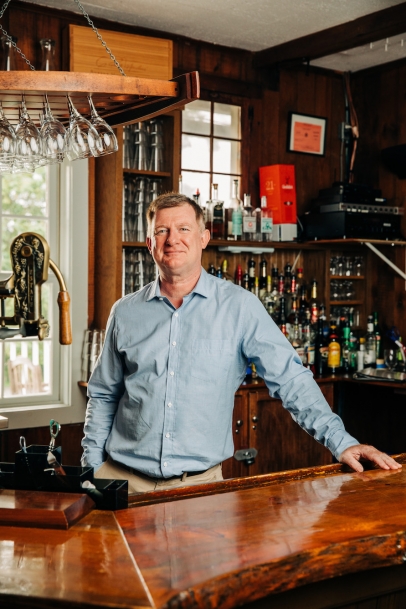Carey Institute for Global Good
Some of the greatest philosophers and thinkers in human history—including Saint Francis of Assisi, Winston Churchill, Oprah Winfrey and Goldie Hawn—all agree that the greatest purpose in life and the best route to happiness is found through helping others.
The HQ for #payingitforward in the Capital District is the Carey Institute for Global Good, perched on a lush, 100-acre estate in Rensselaerville. Whenever we visit its campus for a lecture, a film screening or art reception, we find a happy, joyful place, one that just happens to have a dead-serious mission.
The roots of the Institute go back to 1924 when the home’s then owner Laura Talmage Huyck launched a series of forums on human relations. She was reacting to the carnage of World War I and hoping to promote global understanding and peace through a deeper examination and understanding of differences between countries.
Huyck’s mission deepened and continued over the decades through her daughter, Katherine, and Katherine’s husband P. L. Elmore, who donated the estate to the Institute on Man and Science in 1963. The Institute thrived and grew, and in 2012, the internationally successful businessman and philanthropist William Polk Carey purchased the campus with the goal of “bringing together innovative and dynamic people from around the world to seek creative solutions to the most pressing challenges of the day.”
Since officially launching in 2014, the Carey Institute has generated $13 million for the local economy. It employs 43 full-time and 35 part-time employees, has hosted more than 1,200 students and 2,600 teachers for workshops and is at present serving educators from 23 countries on four continents. Since 2015, the Logan Nonfiction Program has supported more than 120 fellows from 30 countries. Edible sat down with Carey’s president, Gareth Crawford, to find out more about its panoply of cultural and philanthropic initiatives.
Edible Capital District: I’d love to hear more about how the vision of the Carey Institute has changed since it was founded in 2012.
Gareth Crawford: Our founder, Bill Carey, had three main priorities to serve the global good. These were to create local economic opportunity, to promote New York State with a particular focus on education, and for Rensselaerville to be the center of the universe, which Bill heartily believed in. So, given that mandate, we’ve created a portfolio of programs to meet those goals. Our Sustainable Communities program seeks to revitalize what we call marginalized rural and agricultural communities. Our Logan Nonfiction Program serves investigative reporters and documentarians, who are working on national and global issues, which we think are crucial to an informed and engaged democracy, from all around the world. And our education initiative, the Center for Learning in Practice (CLiP), seeks to improve educational outcomes by supporting teachers and learners in the 21st century.
ECD: How is it funded now?
GC: We have a number of different revenue streams. Bill’s family provided us with a generous gift to begin operations in 2014. We have a number of grants from both local and global funders. And the conference center generates revenues through meetings and weddings. We received significant funding from the Jonathan Logan Family Foundation to support the Logan Nonfiction Program. Local funders include Albany County Convention and Visitors Bureau, Hudson River Valley Greenway, and Northeast Sustainable Agriculture Research and Education. We also received a significant grant for strategic funding to develop CLiP’s Refugee Educator Academy.
ECD: A brewery isn’t the first thing that springs to mind when you think of a nonprofit, but the Helderberg Brewery has become one of the most visible manifestations of your vision as an organization. Can you explain the inspiration for it?
GC: Rebecca Platel started at the institute as the first new hire after Bill bought the property in 2012, before the current programs had been established. Hailing from Rensselaerville, and in pursuit of Bill’s mission to make Rensselaerville the center of the universe, Becca wanted to create something to help connect the organization to our rural community, the surrounding region and beyond. The highly anticipated New York State Farm Brewery Bill was about to be passed, and recognizing an opportunity for the local farm economy and the community of Rensselaerville, Becca made beer her first project. It’s turned out to be a great fit, stimulating rural economic development, adding value to our conference center guests’ experience on campus, providing an engaging forum to connect with our community in our Main Street Taproom, and helping to put Carey on the map.
ECD: How difficult has it been to create 100% New York–made brews? How have you seen local hop and grain growers evolve their techniques in recent years?
GC: In the first year or two of the Farm Brewery Bill, options for New York State hops and malt were somewhat limited. Growers and processors were still in the early stages of starting up. It wasn’t impossible to brew with 100% New York State ingredients back then, but if you were only brewing with what was available, your beer styles would have been limited. Since then, the quality, quantity and variety of raw materials have improved vastly. Growers’ knowledge of best production practices and what brewers want continues to expand, and their commitment to “farm-to-glass” is impressive. Of all the stakeholders involved, farmers have certainly taken the biggest risk. Today we are able to use 100% New York State ingredients in all the beers we produce. For us, it’s an exploration of what’s available, what’s new, meeting new farmers and supporting them as much as we can. We are also very small, which gives us flexibility to experiment and source small quantities of product.
ECD: How does your craft beverage partnership work, and can you share some exciting projects that have happened because of it, or new ones in the works?
GC: When the project started, we were very focused on organizing educational workshops and networking events to engage growers in the new market opportunity and to help build supply chain connections. We’ve since transitioned into using our brewery to host “visiting brewers”—individuals who want more hands-on experience in a brewery or who want to experiment with local ingredients and recipe development. Our first visiting brewer developed a recipe for a Mexican lager and then went on to start his own beer label, Monopolio—an old Mexican beer brand that he revived. In 2016, we hosted another visiting brewer from the Hudson Valley—we tasked him with developing some recipes using raw, unmalted grain sourced directly from a local farmer. We liked the outcome so much we now have a line of “raw grain” beers. Looking ahead, we are starting to explore alternative uses for our spent grain. Right now, it goes to a local farm, but we’re curious about other uses and how to problem-solve around shelf stability and food safety issues.
ECD: Tell me about the new program training teachers of refugees. Are you seeing a great need for it in the Capital District? Are you collaborating with other organizations that work with refugees?
GC: The majority of New York’s refugee resettlement occurs upstate with many families being resettled within the greater Albany area. This project has been developed in collaboration with many in the refugee education field and utilizes a variety of resources, including some from the New York State Department of Education focused on supporting students with interrupted formal education. Refugee resettlement organizations and newcomer/international schools have been supportive partners as well, helping to spread the word of this pilot initiative and providing insights into the refugee communities they serve. Developed using our Sustainable Learning Framework, this initiative seeks to empower educators, creating opportunities for them to learn in practice and in dialogue with colleagues. This pilot runs for three years (2019–2021) in the states of New York, Arizona and Washington. One hundred and twenty teachers across the nation will join this learning community and participate in a 12-week online course. The participants will offer feedback on our learning design, dialogue with colleagues from various states, schools, grade levels and content areas, and enjoy the support of a refugee teacher facilitator/coach throughout the 2019–2020 school year.
ECD: I’d also love to hear about the programs you have for journalists and writers; how is your program different than many other grant programs for writers?
GC: The Logan Nonfiction Program is the leading fellowship program in the United States that exclusively supports longform nonfiction. There is no other program with this exclusive focus. Since our inception in 2015, we have directly supported more than 100 nonfiction storytellers from around the world, including award-winning writers, documentary filmmakers, photojournalists, podcasters and multimedia reporters. Logan fellows receive lodging, meals, professional workshopping and community support for up to 10 weeks on the Carey Institute for Global Good’s historic campus in upstate New York during both the spring and fall. Each term, we seek to assemble a diverse and inclusive community of fellows working on socially relevant political, health, environmental, human rights and justice topics. Work produced in our program has gone on to appear on the New York Times’ “10 Best Books of 2018”; place on several bestseller lists; win the National Magazine Award; be nominated for an Academy Award; win a Sundance Special Jury Prize; and much more.
ECD: Do you think this is a dangerous time for freedom of the press?
GC: Yes, without a doubt. Press freedom worldwide has been increasingly under attack. Journalists everywhere are faced with unlawful arrests, digital intimidations and severe physical violence. According to the Committee to Protect Journalists, 2018 was the deadliest year for the press in the last three years, with at least 53 journalists killed on the job and 250 imprisoned worldwide. In the U.S. alone, press freedom—established in the First Amendment in 1787—has been significantly under attack in the past several years. Increasing anti-press rhetoric has led to more physical assaults on American journalists, and the U.S. only ranks at number 48 (out of 180) in the 2019 World Press Freedom Index, dropping three points since 2018.
ECD: Carey has such a broad range of focuses—justice, freedom and sustainability. Would you say that you devote equal energy, funds and staff to each area?
GC: The Carey Institute does have a broad range of focuses that are all designed to support our mission of building a strong, educated and just society. We view each of our programs as essential to this work—the Logan Nonfiction Program ensures the publication of deeply reported facts; the Center for Learning in Practice is committed to improving education outcomes for communities worldwide; and the Sustainable Communities program cultivates regional economic resilience. We believe all of these are essential.
Carey Institute for Global Good | @careyinstitute
Jonathan Logan Family Foundation
Albany County Convention and Visitors Bureau
Hudson River Valley Greenway
Northeast Sustainable Agriculture Research and Education
Helderberg Brewery
Monopolio | @cervezamonopolio






